






















classified
CCCCCCCCCCCCCC Crème Confidential
Dear Reader,
I’m going to let you in on a secret: a boy from Tinder, your grandmother, and a close friend all have something in common. Don’t believe me? Let me explain.
If you’ve ever been on a dating app, some suitor has probably hit you with the line “I know a spot.” Whether it be his favorite makeout shack above Ithaca Falls or a basic restaurant in the Commons (that you’ve already been to but feign interest anyway), he takes pride in showing you something undiscovered in hopes of courting you.
In a similar vein, your grandmother likely has a trove of secret recipes. They could be inherited from the mother of her mother or adapted from cookbooks that nobody reads–either way, I don’t know any grandma who wouldn’t cut you (out of her will or straight across the jugular) for sharing those recipes with a stranger. Like the boy from Tinder, she’s proud of her proprietary knowledge, safeguarded year after year by a little box in her kitchen.
Then you have that one close friend who is a mastermind in the kitchen. They have quirky, obscure, and sometimes downright outlandish tricks for making dishes. There are times when you’re even scared to cook with them because they’ll make slight jabs at your culinary skills. Your ego may be hurt, but you can’t deny that their hacks have merit.
If these examples hint at anything, it’s the larger theme that we–just like the caricatures above–like knowing things that others don’t. It’s a fondness that keeps our magazine going, a lust for knowledge that keeps us in constant search of secrets and hacks that have yet to be discovered. Whether we stumble on them serendipitously or through weeks of experimentation, the secrets of our magazine fill us with immense pride.

The point of this “Confidential” edition is to give you, dear reader, a glimpse into the clandestine and covert culinary world that Crème members live by. To us, this world subsists on holes-in-the-wall on the far side of town, unconventional ingredients sourced from the depths of Wegman’s, and useful hacks that bring cooking to the next level. Some facets of this world may come as a surprise. Some may even shock you. Whatever the outcome is, we hope you enjoy the beans we have to spill.
So after reading this edition, be prepared to join the ranks of Tinder boys, grandmas, and quirky friends of our lives. Their secrets may be out, but I promise we’ll keep yours confidential.
Robert Brooks, President & Editor-in-Chief
Photo by Emily Lam Cover Design by Ashley Jian
from the Editor Tacos CDMX: A Taste of Mexico in Ithaca Snacks You Probably Knew You Needed Ravioli Chips Smash or Pass The Cart of Surprises A Family Love Affair with Our Rice Cooker Eggtastic The Well Kept Secret of Statler Press Bay Alley The Dos and Don’ts of Dining Out The Magic of the Prickly Pear SPM Empanadas: Home on Wheels The Simple Secret to Elevating Dumplings 4 6 7 8 10 11 12 14 15 16 18 19 20
by Angela Lee, Ashley Jian,
Hyland, Helen Sturman, Odessa Thompson
Sun, Effat Rahman, Grace Wilkey, Jessica Li, Laura Gries,
Austin,
Contents
Letter
Designed
Chayil
Edited by Caroline
Sarah
Tyler Fouch Cover
Tacos CDMX: A Taste of Mexico in Ithaca
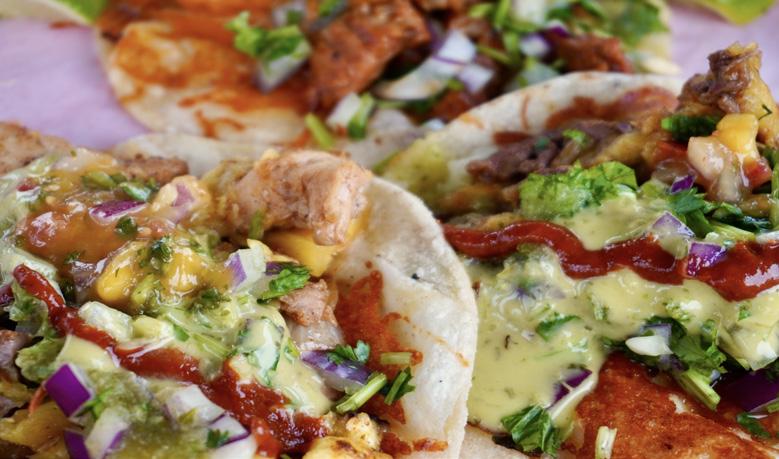
 By Parker Piccolo Hill
By Parker Piccolo Hill
It’s hard to get a good taco in Ithaca, but Tacos CDMX, a little corrugated metal stand in the parking lot of the ReUse center, is successfully changing that.
You probably haven’t heard of it because of the lack of marketing—the sole advertising for the stand is a white sign on the side of the road that says “Tacos!” and features a few hand-drawn arrows. Yet, every time I’ve been, there’s been a line out the (nonexistent) door. The stand opened over the summer and has become a booming business thanks to word of mouth.
Standing in line, it was easy to see why everyone and their mom have been recommending the stand. The aroma of grilled meat and the sweet sound of guitar waft on gentle breezes, while chatter rounds out the background noise. The ambiance of the stand allows for chatter between customers, despite everyone being strangers prior.
Out of curiosity, I asked a few of them what they liked about Tacos CDMX. Kristen, who had brought a whole group of her coworkers, praised their small business feel and authenticity as a former resident of Mexico City (for which the stand is named— CDMX is an acronym for Ciudad de Mexico). Before their opening, she said, it was impossible to find a good taco in Ithaca. Sam, another waiting customer, agreed. He’s a regular at the stand, drawn to it simply because the food is so good. The best tacos outside of California, he claims.

I have to agree. Eduardo and his team (one of whom is a Grammy-nominated producer) work in perfect tandem flipping tortillas and grilling up meat. Each one of the three tacos they offer is flavorful and delicious, for the mouth as well as the eyes. But the food is only part of what draws me to
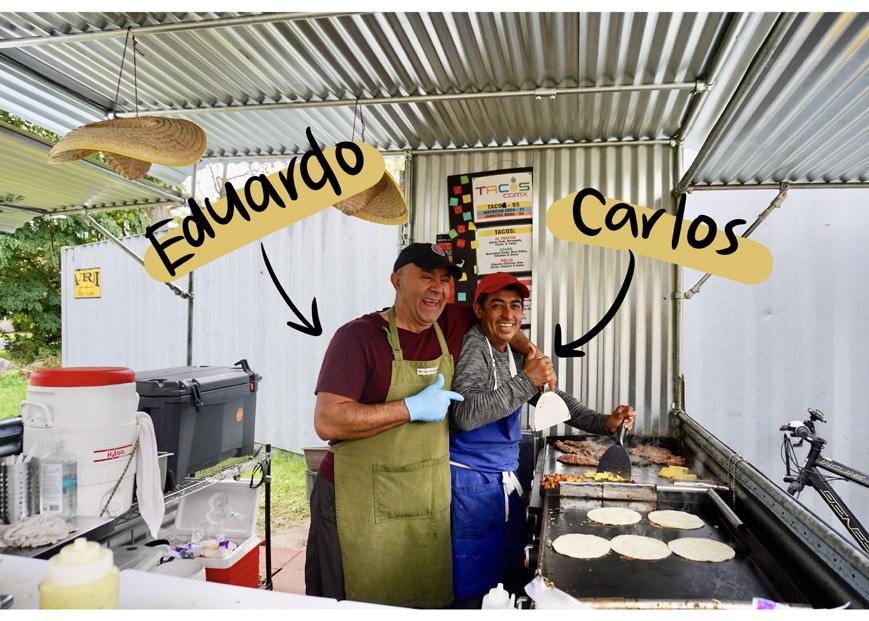
the stand. It’s impossible to pass up the sense of community that Eduardo touts as his proudest achievement. “It’s all about the community,” he said to me multiple times during our interview. He’s not all talk, either. Tacos CDMX is part meal, part stand-up comedy. Eduardo loves nothing more than banter with his customers. Once, he shouted at the line, “Spanish only!” Despite it being a joke, he was surprised by how much of an effort people made. “Everyone’s educated,” he pointed out.
“This is a college town.”

With his humor, Eduardo tries to put people at ease, taking his cues from the taquerías in Mexico City that he grew up on. “[The taco sellers] are the soul of the community [in Mexico],” he remarked. Everything and everyone revolves around them. When he moved to Ithaca for his wife’s position at the Nolan School of Hotel Administration, he was horrified by the lack of quality Mexican food and decided to open up Tacos CDMX to counteract that. Its modus operandi is simple: good food, the sort that you would get in any more in Mexico. In fact, home cooking is exactly what it is. Neither Eduardo nor any of his employees have a food service background. When I asked him where he learned how to cook, he just laughed. “I’m Mexican! It’s part of our culture.”
Food is culture, and food is community. These two credos form the basis of Tacos CDMX, which is all about building up the community. In fact, the first time I went, I didn’t realize it was cash only. Despite having no way to pay, he gave me a taco, waving off my protestations that I didn’t know when I could be back to pay him. “I trust you,” he said.
Now, it’s your turn to trust me. Believe me when I say if you go to Tacos CDMX, not only will you walk away full-bellied, you’ll leave with a fuller heart.
The Crème Lowdown:

Recommended:




The al pastor taco is a delicious blend of savory meat, fresh cilantro and onion, and sweet roasted pineapple. The combination of these along with the signature salsas and the tortillas imported from Chicago create an absolutely exquisite experience that has to be tasted to be believed. Be wary if you’re a vegetarian: there are currently no nonmeat menu options.
When to go:
If you want to get a taco before they run out, go right before the lunch rush around noon. Due to their popularity, ingredients are gone by 3 PM at the latest, although technically the stand is open Monday through Saturday, 11 AM to 4 PM.

Crème Confidential:
Despite not being on the menu, Tacos CDMX has recently begun offering tamales. After finding a local family who makes tamales, Eduardo proclaimed them “authentic” and now has them at the stand. Ask for the pollo tamale!
Prices: $5/taco $1/soda
4 5
PHOTOS: Caroline Geller
Snacks You Probably Knew You Needed

















 By Hannah Rosenberg
By Hannah Rosenberg


I am sitting in a booth on the second floor of Mann. Taylor Swift’s Fearless (Taylor’s Version, of course) is blasting through my earbuds. I am attempting to read an article about federal fishing laws on my computer, but I start to lose focus. My eyes wander towards the swaying trees outside, flushed with autumnal orange. My attention shifts back to fifteen-year-old Swift assuring listeners that there are greater things than “dating the boy on the football team,” and as I float off into burnt out oblivion, I realize one thing in crystal-clear definition: it’s time for my afternoon snack.

Another time, another me: I am on a yellow school bus. I push my backpack up against the silver wall of the bus, and I lean on the green, fraying seats as I fade in and out of sleep with every hard stop of the bus, groan of the engine, and murmur of the upcoming APUSH test. In my moments of startled consciousness, I begin envisioning my afternoon snack. What should I eat today? Chickpea cookie dough with pretzels and apples? (It was a phase). Minimalist’s Baker’s banana bread granola that I had made that morning, sprinkled atop Greek
yogurt and out-of-season, humongous, watery strawberries? A warmed Quest Bar? (Another phase). Dollops of almond butter with a crisp farmer’s market apple?

Forever and always, I am one of B.F. Skinner’s dogs, conditioned to want a snack as soon as the last bell of the school day rings, even as a college senior, deprived of real school bells and drowning in the existential agony of the future (which isn’t too far off from senior-year-of-high-school me). From my library booth, I sip Copper Horse’s Rumble Pony blend of coffee and reminisce on my K-12 routine, on how a silly little school bell began my lifelong cravings for a filling, sweet and salty after-school snack. I am well past riding a school bus, cramming for Spanish tests, and arguing with my twin sister from across our kitchen table, but that 3PM snack sticks around. It never fails. It transports me back to simpler times. And while none of this may be exactly confidential, revisiting an old snack or trying a new one may just give you that ninth-grade, picture-day perfect smile (sorry not sorry).
By Mira Harris
In the midst of prelims season, the time has finally come for me to reveal to the world one of my most treasured meal hacks: the ravioli chip. Crunchy on the outside, dusted with flaky salt and red pepper flakes, and stuffed with a smooth ricotta, this chip is the perfect midnight study snack. Now, I’m not going to act like I invented either of the components of this recipe. I do, however, believe that through trial and tribulation, I’ve streamlined the process so that it is accessible to even the most average chef.
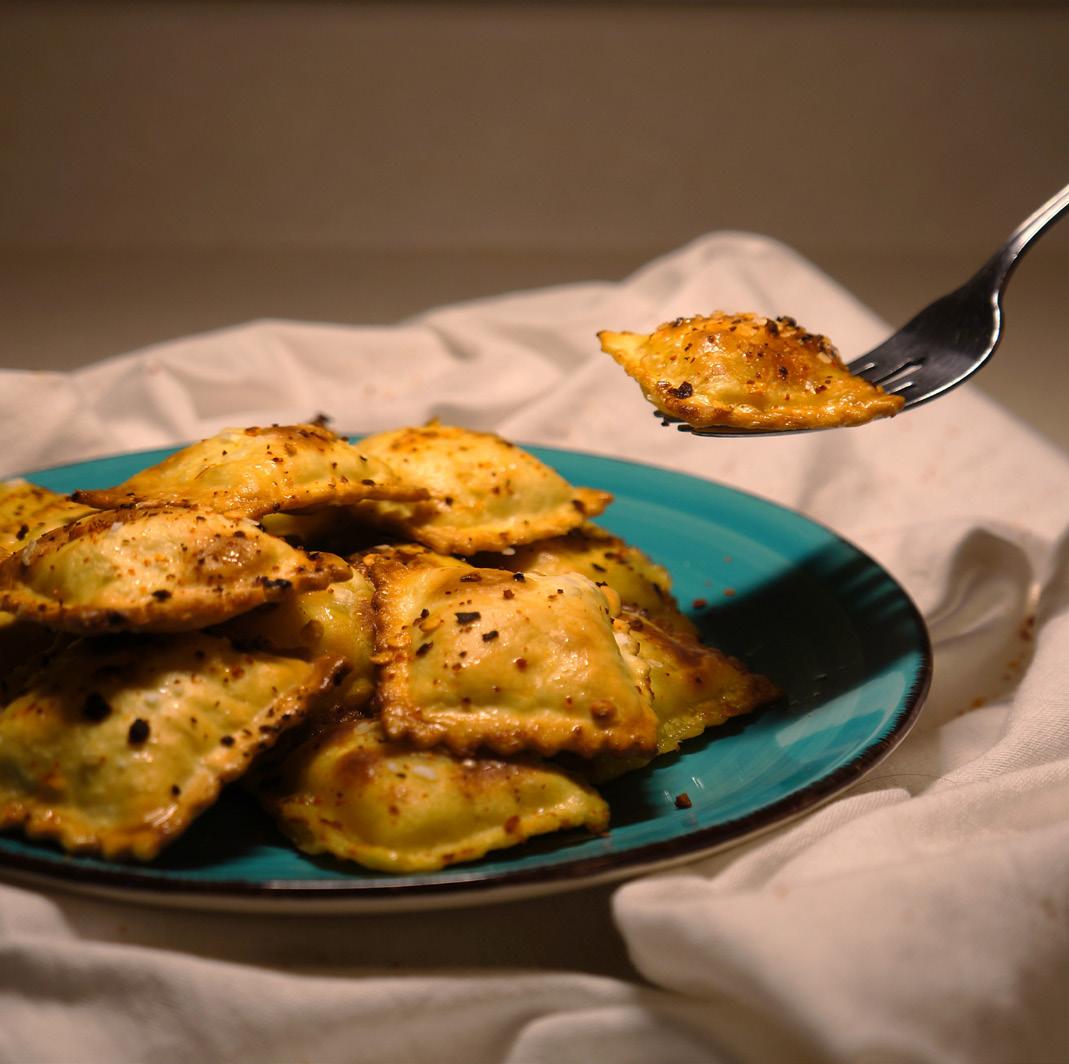
IVAR O LI CHIPS

1: Selecting Your Ravioli: Using square-shaped frozen ravioli (available at just about every grocery store) is a must for this recipe. Square ravioli is essential for maximizing surface area and edges, which will be important for a crispy, crunchy exterior.
2: Boiling: Drop the frozen ravioli into boiling salted water. Once they rise to the surface, immediately remove (al dente is a MUST to achieve the right texture) and place on a foil lined baking sheet.
3: Seasoning: Generously drizzle the ravioli with extra virgin olive oil. Sprinkle on some flaky salt, black pepper and any spice combination your heart desires. My staple additions are granulated garlic and red pepper flakes.
4: Baking: Bake at 400° F (204°C) for about 15 minutes to crisp up the bottom of the ravioli. Fin ish by turning the broiler on high until the tops are gold and toasted.
5: Enjoy your ravioli: Stick them on a plate or eat them right off of the baking sheet!
All in all, this is a recipe that should take you less than five minutes of active cooking. It’s perfect for those exhausting late nights when the only thing you’re capable of doing is boiling water and sticking a sheet tray in the oven. Oh, and to anyone who might say that it’d be way easier to just make regular ravioli smothered in a store-bought marinara. I’d have to say “it’s a texture thing”.
PHOTO:LauraWu
6 7
PHOTOS: Hannah Rosenberg
By Madi Yeh and Odessa Thompson
classes, an o-week party, or elsewhere on the vast sprawl of the Cornell campus. We foundeach other at Kokos. Since then, food has been one of many common loves in our friendship.When we hear about a new restaurant in town, are feeling particularly adventurous, or are justlooking for a midweek pick-me-up, we can always count on each other to be foodie partners-in-crime. The places that we’ve discovered since freshman year have diversified greatly sinceour Kokos days (which of course we still love). We’ve seen many of the epic highs and lows ofthe Ithaca food scene, and these are our personal recommendations: Our go-tos and must-nots, what’s been hitting and what’s been flopping.
Allechant

Naively, freshman Madi and Odessa thought that the only restaurants in Ithaca were located downtown. However, on a hunt for the best brunch in Ithaca, we stumbled upon Allechant, an ambient French restaurant located on Hanshaw Road within walking distance of North Campus. After waiting weeks to finally get a reservation, we headed over for a Sunday brunch, both ordering the Eggs Edinburgh and a warm Chai Latte to keep us warm during the January freeze. Since then, Allechant and their bulldog, Gretel, has held a special place in our hearts.
Our Recs: Madi: French Toast “Eclair” and an Iced Americano Odessa: Eggs Edinburgh and an Oat Chai Latte
De Tasty
Since early on in her freshman year, Madi has been on the hunt to find the number one Chinese food place in Ithaca, dragging Odessa all around town to find some of the best–and inevitably, some of the worst–Chinese spots in town. On a cold winter day, we found ourselves timidly marching down the De Tasty stairs only to open the door and be taken aback by the fragrant, warm, and spicy smells of De Tasty’s food. The basement was packed with college students, even on a weekday night, bustling and full of life. Already impressed by the warm and lively atmosphere, it’s safe to say that the food didn’t disappoint either. After the first bites of steaming rice, smoky wok fried lo mein, and numbingly spicy pork, we knew that we had found our home away from home in Ithaca.
Our Recs:
Madi: Three Pepper Chicken and Twice Cooked Pork

Odessa: Garlic Eggplant Casserole and House Special Lo Mein


Gorgers
After naively walking to the Commons one wintry night for a bite to eat, we quickly realized that very few restaurants on the Commons are open past 7PM on a Tuesday. Stranded by the TCAT, we stumbled across Gorgers across from The State Theater, which was warm and bustling with funky rock tunes. Safe to say we’ve been in love since. Their wax-paper wrapped signatures serve up the highest quality-to-quantity ratio we’ve seen in Ithaca. Not to mention their impressive daily handmade doughnuts and multitude of vegan and vegetarian options.
Our Recs:
Odessa: Blue Fire Sub and Strawberry Coconut
Lime Lemonade
Madi: Mushroom and Swiss Steak Sub


Lev Kitchen
On another mid-afternoon walk to the Commons, we discovered the soft opening of Lev and were drawn in by the friendly staff and mouth-watering smells. We were both recommended the shakshuka malawach and were instantly sold by the contrast of the crispy and flaky wrap to the warm and tangy tomato, egg, and arugula filling. With the restaurant’s lovely, warm ambiance, and outdoor seating area, Lev has now become one of our favorites in Ithaca. Grab yourself a bottle of hard cider from the Lev fridge, a malawach, and some good company, and you’ll have yourself a perfect meal. Since our first visit, we’ve been on a personal mission to try everything on the menu.
Our Recs:



Madi: Chicken Za’atar Malawach and Kennebec French Fries


Odessa: Shashuka Malawach

Passes
Places you might not have heard of in Ithaca— and for good reason. Too often have we walked away with promises unfulfilled and stomachs unsatisfied.
Ithaca Halal
Not to be confused with the new Eddy Street Halal truck, Ithaca Halal has let us down with cold unseasoned chicken and rice one too many times.
Coltivare
New American cuisine is perhaps the bane of our foodie existence. There’s nothing special about this “new” American cuisine; if you’re looking for a classy meal, try Mia or Simeon’s instead.
8 9
PHOTOS: Laura Wu
THE CART OF SURPRISES
By Effat Rahman

As a Muslim student at Cornell, I am intimately acquainted with the struggle of finding goodquality halal food in Ithaca. When I saw the tiny glow of the Halal Brothers cart from my apartment window, I knew I had to try it.



Halal cart cuisine generally consists of meat, rice, salad, and sometimes pita, topped off with a red and white sauce inspired by harissa and tzatziki. These halal carts are everywhere in New York City, with each cart selling its own proprietary version of “lamb and rice”, among other dishes.
Ithaca Halal Brothers Cart opened on August 15th, 2022, and likely remains unknown to many students. When we first moved in, my roommates and I speculated on what the distant glowing box out on the street was. It was only when I squinted and saw the glowing letters “CHICKEN OVER RICE” that I knew our mystery was solved. Located on the corner of Eddy and Seneca, the colorful cart boasts an expansive menu of traditional halal cart fare: chicken, lamb, kofta, and falafel platters served over rice.
I had the pleasure of visiting the cart recently and decided to order the “lamb over rice” platter. Ten minutes later, I was greeted with a sizzling plate of roasted meat and caramelized onions and peppers, all served over a bed of fluffy yellow rice. The side of aromatic dolma (stuffed grape leaves) and a cucumber-olive salad added a unique touch.


On my second trip to the cart, I ordered a cheeseburger, and was surprised to receive a burger patty made out of a spicy North African beef sausage called merguez. The owner of the halal cart, Mohsine El Boukhari, hails from Morocco and evidently incorporates aspects of traditional Moroccan cuisine into standard halal cart fare.
According to Mohsine, the cart is open from 11:30AM to 9:00PM on weekdays, but the cart will often stay open later on the weekends. Additionally, the cart has been known to relocate to areas with more foot traffic—such as the ZBT Loud Luxury concert —when the occasion calls for it, further cementing its status among Cornell students. So the next time you want an after-hours meal out of a truck, don’t make the arduous trek to Louie’s up on North. Instead, try out Ithaca Halal Brothers, the newest late-night gastronomic gem in the heart of Collegetown–if you manage to find it.
By Shieana Xie
Whenever I go on vacation, my family always makes sure to leave room in our luggage for my mom’s trusty rice cooker. This rice cooker isn’t your stereotypical $200 Zojirushi rice cooker found in every Asian household, with fancy buttons and timers. No. This sturdy, steamy piece of metal is dented, over a decade old and has three simple functions: Cook, Steam, and Keep Warm. And best of all, it only cost $30. While most people only use their rice cooker for its namesake function, my family uses it for basically everything: Hainanese chicken, turnip cake, and even bread!




My favorite recipe is my mom's version of spare ribs over rice. You can prepare all the ingredients in advance and have a meal ready to go in 30 minutes with minimal cleanup and no supervision needed. Perfect for any day of the week! For a complete meal, I love to throw in some chopped vegetables with the ribs.
PHOTO: Jenny Xiao
Directions:
1. Combine all marinade ingredients except cornstarch together in a small bowl.
2. Use a paper towel to dry the pork before covering thoroughly with cornstarch.
3. Add marinade ingredients to pork in a bag or bowl. Mix together and marinate for 30 minutes or overnight in the fridge
4. Wash rice normally, rinsing until the water runs clear
5. Transfer marinade and pork to rice cooker. Drizzle the oil over the pork.
6. Add jasmine rice and ¾ cup water, ensuring that all the rice is submerged in water.

7. Set rice cooker to “cook”. Enjoy the music (and maybe even improvise some lyrics).
8. When done, mix rice and spare ribs. Garnish with green onions or cilantro as desired.
9. Enjoy your easy, cheap hotel room/dorm/ wherever-you-happen-to-be meal.
Our
A Family Love Affair With
Rice Cooker
Rice Cooker Spare Ribs and Rice ½ pound chopped spare ribs or pork belly ½ tbsp oil ¾ cup jasmine rice Black Bean Marinade 1 tbsp fermented black beans, minced or black bean sauce ½ tbsp cornstarch ½ tbsp soy sauce ½ tbsp xiaoxing wine or water ½ tbsp grated ginger 3 cloves minced garlic ½ tsp sesame oil ½ tsp oyster sauce (optional) 11 TABLE CHECK #
PHOTOS:AishwaryaRajagopalan 10
EGGTASTIC EGGTASTIC
Eggs. So commonplace, so versatile, and yet I used to eat them so rarely. Whether it was a hard boiled egg or a fried egg, the texture and the flavor were just not the best. However, since going vegetarian, I had to find ways other than supplements to stock my body up on protein, and so I turned to the humble egg. Now, here are some of my favorite egg recipes, lovingly from a reformed egg-eater.
Fried Egg Sandwich:
I am all for a good fried egg sandwich, but sometimes, they’re just too heavy for the morning hours. Not this one though–trust me.
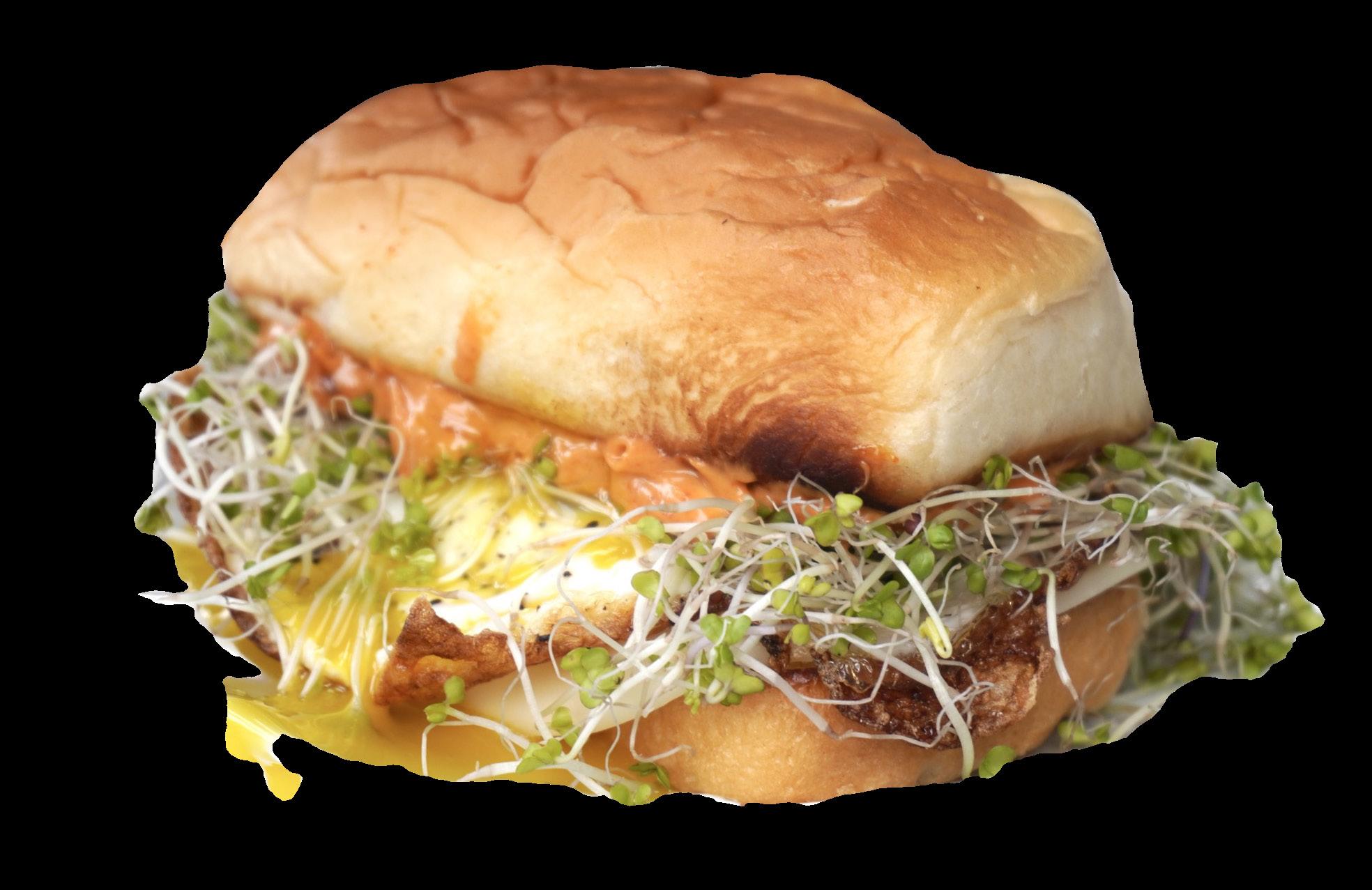
2 slices milk bread (for best results; otherwise, other breads work as well)
1 egg 2 tbsp mayonnaise Provolone cheese
Microgreens
2 tbsp of sriracha/gochujang Neutral oil
1. Spread a dollop of mayo on both sides of the bread slices. Don’t be afraid to layer it on!
2. Place bread slices onto a medium high heat skillet until golden brown. Flip to the other side and sprinkle on provolone cheese. Turn the heat off and place the cover over the skillet to let the cheese melt. Once the cheese is melted to your liking, remove both slices of bread and set aside.
3. Turn the heat to medium high again and add a small layer of neutral oil to the skillet. Once the oil heats up, crack an egg onto the center of the skillet. Salt and pepper the egg.
4. Cook until the edges of the egg turn golden brown with some bubbling in the white. The yolk should still be runny. This should take about 3-5 minutes, depending on how powerful your stove is.
5. Once the egg is finished, add it to the slice of bread with cheese on it. Mix mayo and sriracha/ gochujang in a small bowl using a 1:1 ratio, then layer mixture onto the other slice of bread.
Jammy Eggs:
Jammy eggs are so good on their own and even better marinated. Wait–what is a jammy egg, you ask? It’s when you soft boil an egg and the yolk becomes ooey gooey. Mmm. You can’t go wrong with these; whether it be with ramen, on toast with some avocado or microgreens, or just marinated, making them jammy is the perfect way to enjoy your egg.
1. Boil 3 cups of water in a saucepan. Once the water starts to bubble, add 3 tbsp salt to the water and let the mixture boil for another minute.
2. Slowly drop the eggs in by using a large spoon with a long handle, staying cautious of the hot water.
3. Let the eggs boil for around 6-7 minutes.
4. Strain the eggs. Then, put them in a bowl filled with ice cold water and leave the bowl in the fridge for 10 minutes to cool down.
5. Once the 10 minutes are up, crack and peel the eggs.
Pro tip: Eggs can be stored in the fridge for up to a week!
Marinated Jammy Eggs:
¼ cup soy sauce
2 tbsp honey or brown sugar
2 tbsp gochugaru flakes (or red chili crisps and oil)
2 tsp sesame seeds
1 tbsp sesame oil
½ cup water
3 garlic cloves (finely minced)
2 sprigs green onions
1. Use jammy egg instructions above to boil some eggs.
2. In an airtight container, add all marinade ingredients. Make sure to taste the marinade to ensure it is to your liking.
3. Submerge your newly soft boiled eggs, making sure the marinade covers the tops of the eggs.
4. Let it sit overnight before eating.
 By: Alex Castroverde
By: Alex Castroverde
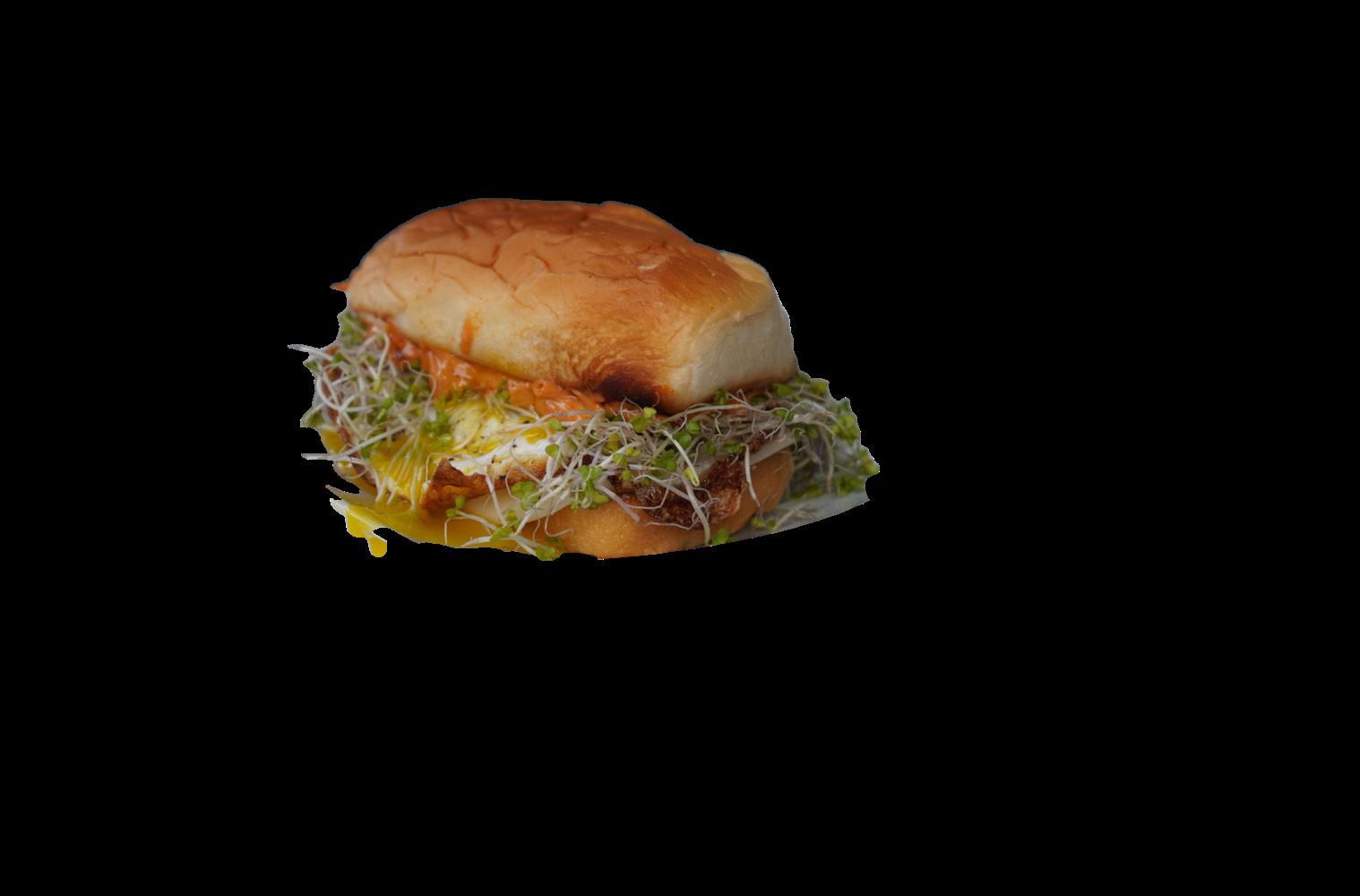
6. Add your microgreens on top, stack it all up, and enjoy!
PHOTO: Anabel Maldonado
These marinated eggs are perfect with a steamy bowl of rice. For an extra touch,. I also like to add a thin slice of butter to my rice and eggs and mix it all up.
1312
The Well Kept Secret of Statler
By Alex Wedgbury

Everyone at Cornell knows of Hotelie Friday (aka Dean’s Dinner Distinguished Lectures Series), where Hotelies dress in business formal attire and attend a semester-long course each fall where a Hospitality Industry Leader comes to speak to the Hotel School. But for us Hotelies who work in the kitchens of Statler, a whole other tradition takes place behind the scenes that reflects us even more than the lecture itself: ‘Dean’s Dinner’.
Each semester, a select few student employees that are a part of the culinary branch of the Hotel Leadership Development Program of the Statler Hotel are invited to prepare a weekly four course dinner and a two course lunch during DDLS season for every single DDLS speaker that walks through Statler. This year, I was fortunate enough to cook for Christina Heggie ‘10, Head of Travel Marketing Strategy for Google earlier this school year.
The weeks leading up to dinner night, I worked with Eric Szymczak, the Executive Chef of Statler to create a Middle Eastern four course dinner featuring pita with sun-dried tomato hummus,
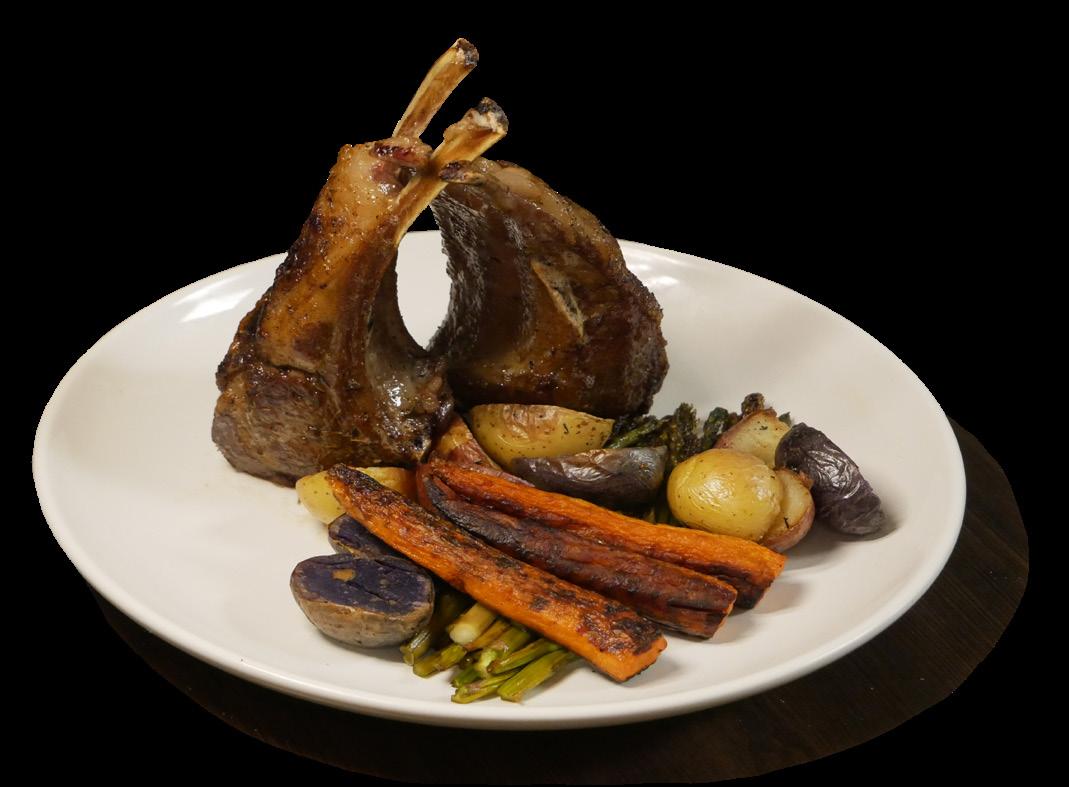
chilled cucumber soup with crostini and toasted almonds, a rack of lamb with grilled asparagus and fingerling potatoes, and for dessert, a pistachio rosewater semolina cake with homemade honey ice cream. For lunch the following day, I prepared poke bowls and homemade sorbet before Christina gave her lecture. I was also fortunate to work with Thomas Gisler, Food and Beverage Director of the Statler Hotel, to choose two Greek wines to pair with my Middle Eastern Dinner, a 2022 Assyrtiko (a light-bodied white wine with high acidity and minerality complex) and a 2020 Agiorgitiko (a medium-bodied red wine with medium tannins and a lovely mid-palate and finish). At the beginning of the meal, I walked through the food and wine pairings and returned to give a signed menu at the end of the meal.
Despite all the hard work during the week leading up to dinner (a total of 30 hours, including preparation and execution), this tradition will be one of the major highlights of this semester and of my Cornell career. And if you’ve ever wondered what happened behind the scenes of Hotelie Friday, now you know.
PRESS BAY ALLEY
By Maria DiGiovanni
As a sophmore transfer admist the height of pandemic restrictions, I had a rather limited social circle. But that never discouraged me from taking to the streets of Ithaca to explore what my new home had to offer. Of these occasional solo excursions, one remains distinct in my mind. On a sunny Saturday morning, I had ventured out to purchase buttermilk for my first Crème de Cornell recipe (now published in Comfort Foods, and a must-read, if I do say so myself) and was trekking back to a downtown bus stop when I caught sight of a row of painted logos on a lone gray brick wall— the first of which advertised “The Press Cafe.” My bus was rapidly approaching in my peripheral vision, but I quickly decided I could not forgo the chance to try a new iced coffee.
In its glorious simplicity, that moment made my solitary Saturday a wonderful one. Unbeknownst to me until that fateful day, this place, tucked into the periphery of downtown, was Press Bay Alley.
So next time you head downtown, I encourage you to ditch the usual destinations in the Commons for a taste of the wondrous. You can find Press Bay Alley on the left side of town, across from Odyssey Bookstore. The row of retailers offers options for morning sunshine or nighttime wanderings.

Start the weekend by grabbing coffee at the Press Cafe and pair it with a sweet hand pie at Mama Said Hand Pies, or end a busy day with local libations from Lucky Hare Brewing Company—along with perhaps a savory hand pie (there is no such thing as too many hand pies).
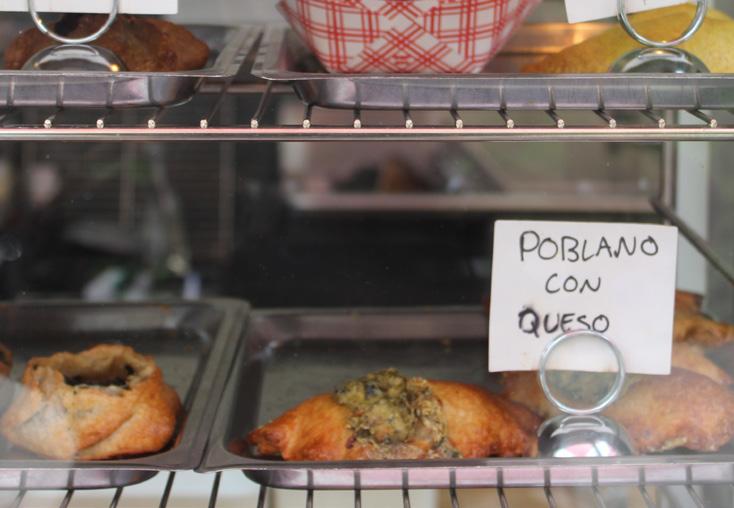
If you visit in November and December, you can find a Holiday Farmers’ Market featuring even more goodies, including cheeses, breads, beverages, and hand-crafted gifts.
Abandoning my ride, I turned the corner and found an enclosed alleyway lined with several small businesses. I walked into a storage-bay-turnedcoffee-shop outfitted with minimalistic decor and wraparound glass windows. After acquiring that much-needed coffee, I stumbled upon another eatery just one door down, Mama Said Hand Pies. From an array of sweet and savory offerings, I grabbed the Irish Knish—a buttery potato hash wrapped in a crisp pie crust.
Seating myself amongst the bustle of patrons, I dined on my freshly-warmed hand pie under the fall sunlight and washed it all down with my Press Cafe coffee.
After finding out that Crème’s own editor-inchief, Robert Brooks, had never heard of Press Bay Alley, I recently hauled Robert and former president Alex Castroverde to try Lucky Hare on a late Friday afternoon. As a lover of sour ale, I bought the Fruit Salad, a pink-hued brew made with raspberry and black currant. Robert and Alex were quickly convinced to get the same, and we sipped our colorful drinks below the string lights until dusk.
And so two years and too many memories to count later, there I was again, enjoying all that Press Bay Alley has to offer—only this time, heading into my final year at Cornell with my friends at my side.
PHOTO:VernaLi
1514
PHOTOS: Maria DiGiovanni
The Dos and Don’ts of Dining Out
By Mikayla Stock
Have you ever wondered if you’re making the most of your restaurant experience? After a long week of mass-produced food in crowded spaces with your peers, you may be anxious to escape Cornell’s dining scene and explore the offerings of Ithaca’s restaurants. When looking to the future, there is a whole new set of considerations that come with knowing we will eventually have to navigate a world where we aren’t constantly swiping IDs and spending BRBs like they’re fake money.
College is the perfect time to refine your knowledge of extracting the most value from your restaurant outings, gain awareness of the industry’s nastiest nuances, and learn how to be a kinder diner.
Whether you’re a seasoned restaurant goer or a complete novice, there are many subtleties to note. So, without further ado and in honor of the times when we choose to brave the TCAT to explore Ithaca’s eateries (with some help from those who know the industry far better than I do), I am here to bestow upon you my unofficial guide to the dos and don’t of eating out.
DOS
Adam Monteverde, CIA alum, Chef/Owner of APizza!, and my very own brother, makes the following recommendations for diners:
1. “I always like to start with the chicken entree for my first time at a new[…]restaurant. Really gives you a great window into what the kitchen is capable of, considering that chicken is such a humble ingredient.”
2. “Depending on the level of [the establishment] , or when it’s appropriate, I’ll ask the server what to try at that restaurant, always going with the first answer. You can do this with almost every course of your meal.”
3. “Tip well if it’s allowed.”
On another note, I have a few tips of my own:
4. Do be wary of clams, mussels, oysters, etc. Even if the quality is top notch, a bad one could be lurking in the bunch.
5. Do call ahead if you can’t make a reservation. Don’t show up late expecting your table. A lost table can mean lost profits when you consider the restaurant’s costs that won’t be covered if the table remains empty because you no-showed. Communicating any changes in your arrival is essential.
6. Do always be kind to staff members. Don’t be rude or entitled. Working in a service industry is no walk in the park.
7. Do be open to trying new things. The culinary experience is one for the senses, so take it all in.
8. Do check the cleanliness of the bathroom. If a restaurant isn’t taking proper care of one of the less desirable areas of the establishment, then I don’t even want to know what’s happening in the back-of-the house.
DON’TS
The beloved Anthony Bourdain made some important points in his article for The New Yorker, “Don’t Eat Before Reading This.” Here are some highlights:
1. Don’t order fish on Mondays. Assuming`the chef orders fish for Friday morning, most purveyors don’t deliver on Saturdays. As Anthony put it, “the chances are that the Monday-night tuna you want has been kicking around in the kitchen since Friday morning, under God knows what conditions.” Scrumptious.
2. Don’t order your steak well-done unless you want the potential of getting the “particularly unlovely piece of steak—tough, riddled with nerve and connective tissue, off the hip end of the loin, and maybe a little stinky from age.” Yum.
3. Avoid the hollandaise sauce. According to Anthony, eggs benedict is not a favorite to prepare amongst chefs, so the sauce may not be as good for consumption as you would like.
And some tips I’ve gathered:
4. Avoid ordering featured items. These dishes may contain ingredients that the kitchen is trying to sell while they’re still edible.
5. Don’t fret over brand name alcohol when ordering drinks. As Crème’s wonderful VP Grace Wilkey reminded me, the house tequila is just fine.
6. Maybe don’t put that lemon in your water. Why, you ask? It could be that the lemon has been sitting out unwashed for days without refrigeration. Or perhaps I’m just an anxious gal who took her mom’s advice on lemon water to an unhealthy level.
7. Avoid the bar snacks. Snacks sitting out all night that everyone and their mother has been putting their grubby fingers on sound delicious. Not.
8. Perhaps you should avoid that bread basket, too. Debra Ginsburg, author of Waiting: The True Confessions of a Waitress, claims that bread baskets tend to make their rounds from table-to-table. Still want to grab a piece?
So there you go! I give you all of my deepest, darkest secrets to use to your advantage (you’re welcome). Keep them in mind the next time you eat out, or feel free to disregard them entirely. Whatever you choose to do, I wish you the best on all of your culinary adventures.

1716
PHOTO: Aishwarya Rajagopalan
HOME ON WHEELS SPM EMPANADAS: The Magic of thePrickly Pear

 By Garrett Emmons
By Garrett Emmons

As a kid in northern California, coming across a cactus was always an adventure. The cacti in my hometown were large jumbles of green paddles covered in thorns. My eyes were always drawn to the mysterious green and red fruit at the end of the paddles—the jewels called prickly pears. All these years later, the prickly pear has never lost its magic to me.
To people from areas in Mexico or the American Southwest where cacti outnumber all other plants, prickly pears might seem commonplace. After all, the Mexican flag features the hardy plant and
Arizonan souvenir shops are replete with prickly pear opuntia products, from candies to hot sauces. Still, it remains an underappreciated and underutilized ingredient in most of the United States. My goal is to change that–at least, for you.
If you grab a prickly pear fresh off the cactus, it will have little spines that need to be removed. Fortunately, if you’re buying them at a grocery store, such as the Wegmans here in Ithaca, the spines will often have been removed already. In that case, simply cut it in half lengthwise and then scoop out the juicy flesh, which may be red, yellow, or green—all ripe. You can eat it raw, though it does have crunchy edible seeds which most people spit out. The taste is often described as a unique mix of watermelon and bubblegum.

Prickly pears have a relatively low acid content compared to other fruits, and so the most successful recipes will brighten it up with extra acid. Chop it up and combine it with onion, serranos, lime, and cilantro to make a modified pico de gallo. Saute it with shallots and garlic in olive oil, deglaze with red wine, and blend with some balsamic vinegar to form sauce for pork tacos or ricottaspinach ravioli. Reduce it in a saucepan with some sugar before straining it to produce a syrup. Add that to your next margarita or shake it with gin, campari, and lemon juice to create a sweet, sour, and bitter Italian-inspired cocktail. For any recipe that calls for a little sweetness, prickly pears are worth experimenting with.
So next time you see a prickly pear on a cactus or at the store, don’t shy away from it. Rather, bring it home and experience the magic.
By Anabel Maldonado
Dinners at the Maldonado household always consist of smiles, laughter, and an overly abundant amount of Argentine food equivalent to days worth of leftovers. Well, leftovers of everything except the empanadas — those vanished in seconds. And for good reason: the Maldonado empanada is the star of every meal and the object of my most mouth-watering dreams. For me, this flaky pastry filled with various spicy seasoned meats and vegetables is home. The buttery aroma with hints of oregano, chili peppers, and garlic is home. The sound of sizzling grease in the oven and Spanish music echoing through the kitchen is home.

Sadly, finding a taste of this home away from home is not easy here in Ithaca. As a Cornellian desperate for Argentinian comfort food, I struggled to find the empanada spot until this year. A friend of mine, also searching for authentic empanadas, recalls a five-minute uber ride conversation with a soon-to-be empanada food truck owner. Even though the short ride was at 2AM and two years back, she had been following his food truck journey ever since.
This March, that journey finally bloomed into savory, delectable fruition. Although the location changes daily, updates can be found on their
Facebook page. Thus, before our very first muchawaited visit, we looked up the address and drove thirty minutes to hunt down the so-called best empanadas in town.
When we arrived, we spotted the black and red food truck with a line of happy customers, and we knew we were in the right spot. We started our meal off with beef and chicken empanadas. As soon as I heard the crunch, I was transported back to home, to sizzling grease and Spanish tunes. Buttery crust melts on my tongue. Herbal spice fills my senses. The juicy, earthy meat is complemented perfectly by the garlic and lemon in the Spm’s “Dominican Republic sauce.” I am left wanting another bite, and another, and another. After tasting their empanadas, we couldn’t resist heading back to their truck to order fried Dominican salami with fried plantains, the perfect complement to the empanadas.
We wrapped up our meal with a new Spm Empanada dessert dish that was featured in Ithaca’s annual Apple Fest. Surprisingly, this was my first time trying a dessert empanada, and I don’t think it gets much better than this. But why listen to me? Instead, go try it for yourself!
18
19
PHOTOS: Emily Lam
PHOTOS:Anabel Maldonado
The Simple Secret to Elevating Dumplings
By David Cai
Dumplings are a staple in any Chinese household, with many families’ recipes dating back generations. Most recipes have a similar basis, with a homemade wheat wrapper surrounding a filling of classic Chinese ingredients. But the simplicity of this beautiful recipe allows for personal variety: dumplings can be pleated and folded in so many visually stunning ways, resulting in a perfect, family-personalized combination of flavors, textures, and looks.
While many dumpling restaurants have perfected their wrapper ratios, their delicate
pleats, and their savory fillings, my favorite way of elevating this Chinese basic is with color. Why settle for plain beige when you can have green, purple, pink, and yellow?
You won’t be able to find these wrappers at grocery stores, but I promise they won’t twist your head in knots trying to make. In fact, if you’ve ever had any sort of gripe with storebought wrappers, making your own is the solution. Doing so gives you more flexibility and creative freedom than ever, along with the possibility of a pop of color to light up your dinner table.
Basic Dumpling Wrappers (about 25 wrappers)
INGREDIENTS: 2 cups all-purpose flour ½ cup warm water
1. Place flour in a bowl.
2. Microwave water until warm and pour it into a bowl.
3. Mix the water and flour. The flour will start off shaggy but constant kneading should form a large dough ball. You can add more water or flour to reach the desired consistency.
4. When the ball of dough is fully formed (poking the ball should cause the dough to spring back slightly), let the dough rest at room temperature for at least 30 minutes in a covered bowl.
5. When the dough is fully rested, roll out the dough onto a large surface into one long strand about ½ inch in diameter.
6. Cut the dough strand into 1 inch long segments (about two knuckles wide). Segment sizes can be adjusted for smaller or larger wrappers.
7. Roll each segment into a uniform ball using your hands. Using a rolling pin, roll each small ball of dough into a flat circle. The wrapper is now complete. When folding/pleating your dumpling, simply use water on the edges of the wrapper.
Colored Dumpling Wrappers
INGREDIENTS:
Carrot Juice
Beet Juice
Red/Orange/Yellow/Green Bell Pepper Juice Zucchini Juice
Spinach Juice Purple Cabbages
*all vegetable juice quantities can be adjusted to personal liking
RED: Red bell pepper juice or a little beet juice can be used for red. Both juices can be made from blending or pureeing the vegeta bles, and then straining for the juice.
ORANGE: Carrot juice or orange bell pep per juice can be used. Both juices can be made with the method mentioned for red wrappers.
YELLOW: Yellow bell pepper juice can be used. Same method as above to make the juice from scratch.
METHOD:
To make dumpling wrappers colorful, simply add some juice to your warm water. Adding more juice can saturate the wrapper’s colors, while adding less juice can make a lighter or fainter colored wrapper.

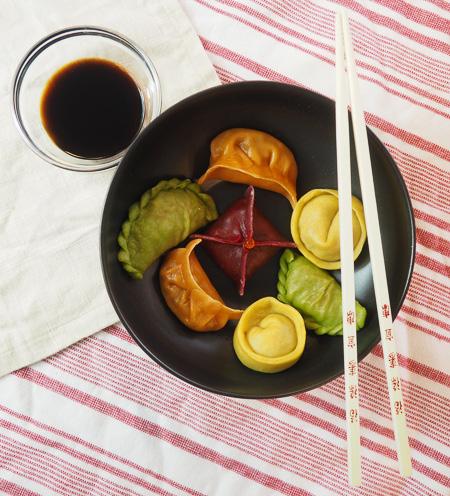
GREEN: Spinach juice can be used for a dark green, while zucchini juice can be used for a lighter color. Spinach juice can be made by quickly blanching the spinach leaves, and then blending and straining. Zucchini juice can be made just by blending and straining the zucchini after peeling the skins off.
PURPLE: Chop a purple cabbage and sim mer in water for 5 minutes. The water will gain the purple color, which can be used for
Jenny Xiao
PHOTOS:
2120
`
C R E M E
d e c o r n e l l

























 By Parker Piccolo Hill
By Parker Piccolo Hill


























 By Hannah Rosenberg
By Hannah Rosenberg






























 By: Alex Castroverde
By: Alex Castroverde







 By Garrett Emmons
By Garrett Emmons




